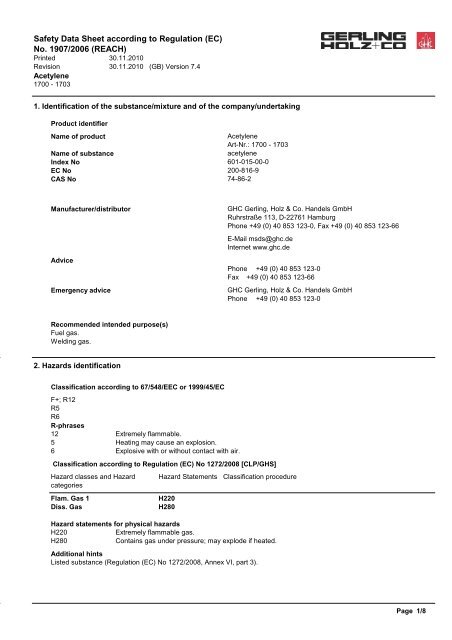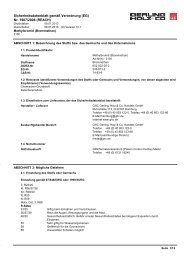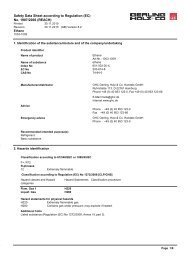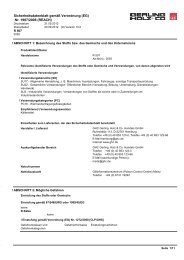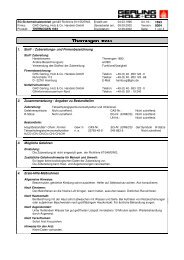material safety data sheet - GHC Gerling, Holz + Co. Handels GmbH
material safety data sheet - GHC Gerling, Holz + Co. Handels GmbH
material safety data sheet - GHC Gerling, Holz + Co. Handels GmbH
You also want an ePaper? Increase the reach of your titles
YUMPU automatically turns print PDFs into web optimized ePapers that Google loves.
Safety Data Sheet according to Regulation (EC)<br />
No. 1907/2006 (REACH)<br />
Printed 30.11.2010<br />
Revision 30.11.2010 (GB) Version 7.4<br />
Acetylene<br />
1700 - 1703<br />
1. Identification of the substance/mixture and of the company/undertaking<br />
Product identifier<br />
Name of product Acetylene<br />
Art-Nr.: 1700 - 1703<br />
Name of substance acetylene<br />
Index No 601-015-00-0<br />
EC No 200-816-9<br />
CAS No 74-86-2<br />
Manufacturer/distributor <strong>GHC</strong> <strong>Gerling</strong>, <strong>Holz</strong> & <strong>Co</strong>. <strong>Handels</strong> <strong>GmbH</strong><br />
Ruhrstraße 113, D-22761 Hamburg<br />
Phone +49 (0) 40 853 123-0, Fax +49 (0) 40 853 123-66<br />
Advice<br />
E-Mail msds@ghc.de<br />
Internet www.ghc.de<br />
Phone +49 (0) 40 853 123-0<br />
Fax +49 (0) 40 853 123-66<br />
Emergency advice <strong>GHC</strong> <strong>Gerling</strong>, <strong>Holz</strong> & <strong>Co</strong>. <strong>Handels</strong> <strong>GmbH</strong><br />
Phone +49 (0) 40 853 123-0<br />
Recommended intended purpose(s)<br />
Fuel gas.<br />
Welding gas.<br />
2. Hazards identification<br />
Classification according to 67/548/EEC or 1999/45/EC<br />
F+; R12<br />
R5<br />
R6<br />
R-phrases<br />
12 Extremely flammable.<br />
5 Heating may cause an explosion.<br />
6 Explosive with or without contact with air.<br />
Classification according to Regulation (EC) No 1272/2008 [CLP/GHS]<br />
Hazard classes and Hazard<br />
categories<br />
Flam. Gas 1 H220<br />
Diss. Gas H280<br />
Hazard Statements Classification procedure<br />
Hazard statements for physical hazards<br />
H220 Extremely flammable gas.<br />
H280 <strong>Co</strong>ntains gas under pressure; may explode if heated.<br />
Additional hints<br />
Listed substance (Regulation (EC) No 1272/2008, Annex VI, part 3).<br />
Page 1/8
Safety Data Sheet according to Regulation (EC)<br />
No. 1907/2006 (REACH)<br />
Printed 30.11.2010<br />
Revision 30.11.2010 (GB) Version 7.4<br />
Acetylene<br />
1700 - 1703<br />
Labelling according to Regulation (EC) No 1272/2008 [CLP/GHS]<br />
GHS02 GHS04<br />
Signal word<br />
Danger<br />
Hazard statements for physical hazards<br />
H220 Extremely flammable gas.<br />
H280 <strong>Co</strong>ntains gas under pressure; may explode if heated.<br />
Precautionary Statements<br />
Prevention<br />
P210 Keep away from heat/sparks/open flames/hot surfaces. – No smoking.<br />
Response<br />
P377 Leaking gas fire: Do not extinguish, unless leak can be stopped safely.<br />
P381 Eliminate all ignition sources if safe to do so.<br />
Storage<br />
P403 Store in a well-ventilated place.<br />
Supplemental Hazard information (EU)<br />
Physical properties<br />
Explosive with or without contact with air.<br />
Information pertaining to special dangers for human and environment<br />
In high concentrations may cause asphyxiation.<br />
<strong>Co</strong>ntact with liquid may cause cold burns/frostbite.<br />
3. <strong>Co</strong>mposition/information on ingredients<br />
CAS No 74-86-2 acetylene<br />
EC No 200-816-9<br />
Index No 601-015-00-0<br />
4. First aid measures<br />
General information<br />
Remove contaminated soaked clothing immediately.<br />
Adhere to personal protective measures when giving first aid.<br />
Seek medical advice immediately.<br />
In case of inhalation<br />
Remove the casualty into fresh air and keep him immobile.<br />
Seek medical treatment immediately.<br />
In case of respiratory standstill give artifical respiration by respiratory bag (Ambu bag) or respirator. Send for a doctor.<br />
In case of skin contact<br />
In case of contact with skin wash off immediately with soap and water.<br />
In case of eye contact<br />
Rinse cautiously with water for several minuts. Remove contact lenses, if present and easy to do. <strong>Co</strong>ntinue rinsing.<br />
Call for a doctor immediately.<br />
In case of ingestion<br />
Ingestion is not considered a potential route of exposure.<br />
Page 2/8
Safety Data Sheet according to Regulation (EC)<br />
No. 1907/2006 (REACH)<br />
Printed 30.11.2010<br />
Revision 30.11.2010 (GB) Version 7.4<br />
Acetylene<br />
1700 - 1703<br />
Physician's information / possible symptoms<br />
Sensitivity to light<br />
Treatment (Advice to doctor)<br />
Treat symptoms.<br />
In the event of pulmonary irritation treat initially with corticoid spray, e.g. Ventolair- or Pulmicort- metered-dose<br />
aerosol (Ventolair and Pulmicort are registrated trademarks).<br />
Monitor circulation.<br />
5. Firefighting measures<br />
Suitable extinguishing media<br />
Dry powder<br />
Carbon dioxide<br />
Water spray jet<br />
Extinguishing media which must not be used for <strong>safety</strong> reasons<br />
Full water jet<br />
Special hazards arising from the substance or mixture<br />
In case of fire formation of dangerous gases possible.<br />
Formation of explosive gas mixtures in air.<br />
In the event of fire the following can be released:<br />
Carbon monoxide (CO)<br />
Special protective equipment for fire-fighters<br />
Use breathing apparatus with independent air supply ( isolated ).<br />
Additional information<br />
<strong>Co</strong>ol endangered containers with water spray jet.<br />
Exposure to fire may cause containers to rupture/explode.<br />
Do not extinguish a leaking gas flame unless absolutely necessary. Spontaneous/explosive re-ignition may occur.<br />
Extinguish any other fire.<br />
6. Accidental release measures<br />
Personal precautions<br />
See chapter 8.<br />
Remove persons to <strong>safety</strong>.<br />
Keep away sources of ignition.<br />
Environmental precautions<br />
If possible, stop flow of product.<br />
Eliminate ignition sources.<br />
Do not discharge into the drains/surface waters/groundwater.<br />
Do not discharge into the subsoil/soil.<br />
Methods for cleaning up<br />
Ensure adequate air ventilation.<br />
Allow to vaporise.<br />
Additional Information<br />
Informations for safe handling see chapter 7.<br />
Informations for personal protective equipment see chapter 8.<br />
Page 3/8
Safety Data Sheet according to Regulation (EC)<br />
No. 1907/2006 (REACH)<br />
Printed 30.11.2010<br />
Revision 30.11.2010 (GB) Version 7.4<br />
Acetylene<br />
1700 - 1703<br />
! 7. Handling and storage<br />
! Advice on safe handling<br />
Use only in thoroughly ventilated areas.<br />
Transfer and handle only in enclosed systems.<br />
Take measures against electrostatically charging.<br />
Barrels and installations thoroughly earthing (grounding ).<br />
Use antistatic tools.<br />
Treatment only in suitable rooms and systems.<br />
Provide good room ventilation even at ground level (vapours are heavier than air).<br />
Prevent cylinders from falling over.<br />
Ensure valve protection device is correctly fitted.<br />
Ensure valve outlet cap nut or plug (where provided) is correctly fitted.<br />
Open valve slowly to avoid pressure shock.<br />
Do not allow backfeed into the container.<br />
Suck back of water into the container must be prevented.<br />
No water to valves, flanges and other fittings.<br />
Purging of pipes and valves with inert gases - to avoid: water, solvents.<br />
Advice on protection against fire and explosion<br />
The product is combustible.<br />
Because of risk of explosion avoid vapours getting into cellar, sewage system and holes.<br />
Take precautionary measures against static discharges.<br />
Formation of explosive gas mixtures in air.<br />
Use explosion-proof equipment / fittings and non-sparking tools.<br />
Requirements for storage rooms and vessels<br />
Keep in closed original container.<br />
Ventilate store-rooms thoroughly.<br />
Use transportable pressure equipment.<br />
Suitable <strong>material</strong>s: Normalised steel and carbon steel, tempered steel, aluminium alloys, stainless steel.<br />
Valve: Suitable <strong>material</strong>s: Brass (Cu < 70%), carbon steels, aluminium alloys, stainless steel.<br />
Unsuitable <strong>material</strong>s: Brass and copper alloys (Cu >= 70%).<br />
Advice on storage compatibility<br />
Do not store together with animal feedstuffs.<br />
Do not store together with food.<br />
Do not store together with oxidizing agents.<br />
Further information on storage conditions<br />
Ensure valve protection device is correctly fitted.<br />
Keep container tightly closed and store at cool and aired place.<br />
Prevent cylinders from falling over.<br />
Storage temperature may not exceed 50°C (=122°F).<br />
Recommendation(s) for intended use<br />
no<br />
8. Exposure controls/personal protection<br />
Ingredients with occupational exposure limits to be monitored<br />
CAS No Name <strong>Co</strong>de [mg/m3] [ppm] Remark<br />
74-86-2 acetylene 8 hours<br />
Short-term 2662 2500<br />
Additional advice<br />
no<br />
Respiratory protection<br />
Keep self contained breathing apparatus readily available for emergency use.<br />
NIOSH, USA<br />
Page 4/8
Safety Data Sheet according to Regulation (EC)<br />
No. 1907/2006 (REACH)<br />
Printed 30.11.2010<br />
Revision 30.11.2010 (GB) Version 7.4<br />
Acetylene<br />
1700 - 1703<br />
In case of rescue and maintenance activities in storage containers use environment-independent breathing<br />
apparatus because of risk of suffocation by edging out of air oxygen<br />
Hand protection<br />
Protective gloves<br />
Leather gloves<br />
Eye protection<br />
Wear goggles with suitable filter lenses when use is cutting/welding.<br />
<strong>safety</strong> goggles, in case of increased risk add protective face shield<br />
Skin protection<br />
protective clothing<br />
General protective measures<br />
Do not inhale gases/vapours/aerosols.<br />
Hygiene measures<br />
At work do not eat, drink and smoke.<br />
Limitation and surveillance of the environment<br />
See chapter 7.<br />
9. Physical and chemical properties<br />
Form<br />
pressurised dissolved gas<br />
<strong>Co</strong>lour<br />
colourless<br />
Important health, <strong>safety</strong> and environmental information<br />
pH value in delivery state not<br />
applicable<br />
Odour<br />
garlic-like<br />
Value Temperature at Method Remark<br />
sublimation point -84 °C 1013 hPa<br />
melting point -80,8 °C under pressure<br />
Flash point -84 °C<br />
Flammable solid not<br />
applicable<br />
Ignition temperature 325 °C DIN 51794<br />
Lower explosion limit 2,3 Vol-%<br />
Upper explosion limit 100 Vol-%<br />
Vapour pressure 44000 hPa 20 °C<br />
Density 0,729 g/cm3 -84 °C liquid phase<br />
Rel. vapour density 0,908 air = 1<br />
Solubility in water 1185 mg/l 20 °C<br />
Page 5/8
Safety Data Sheet according to Regulation (EC)<br />
No. 1907/2006 (REACH)<br />
Printed 30.11.2010<br />
Revision 30.11.2010 (GB) Version 7.4<br />
Acetylene<br />
1700 - 1703<br />
Value Temperature at Method Remark<br />
Solubility/other soluble in<br />
organic solvent<br />
Partition coefficient (log<br />
pOW)<br />
0,37<br />
Viscosity dynamic 0,103 mPa*s 20 °C<br />
Additional information<br />
Poor warning properties at low concentrations.<br />
10. Stability and reactivity<br />
<strong>Co</strong>nditions to avoid<br />
May decompose violently at high temperature and/or pressure or in the presence of a catalyst.<br />
Formation of explosive gas/air mixtures.<br />
Heat sources / heat - risk of bursting.<br />
Materials to avoid<br />
Reactions with oxidising agents.<br />
Hazardous decomposition products<br />
Carbon monoxide<br />
Thermal decomposition<br />
Remark No decomposition if used as directed.<br />
Additional information<br />
Stable under normal conditions.<br />
Dissolved in a solvent supported in a porous mass.<br />
11. Toxicological information<br />
Acute toxicity/Irritability/Sensitization<br />
Irritability skin non-irritant<br />
Irritability eye non-irritant<br />
Skin sensitization not determined<br />
Subacute Toxicity - Carcinogenicity<br />
Mutagenicity not determined<br />
Reproduction-<br />
Toxicity<br />
Value/Validation Species Method Remark<br />
Value Species Method Validation<br />
not determined<br />
Page 6/8
Safety Data Sheet according to Regulation (EC)<br />
No. 1907/2006 (REACH)<br />
Printed 30.11.2010<br />
Revision 30.11.2010 (GB) Version 7.4<br />
Acetylene<br />
1700 - 1703<br />
Carcinogenicity not determined<br />
Value Species Method Validation<br />
Toxicity test (Additional information)<br />
No experimental indication of genotoxicity in vitro ( Ames-test negative ).<br />
Experiences made from practice<br />
Gases have a suffocating effect.<br />
Inhalation causes narcotic effect/intoxication.<br />
12. Ecological information<br />
Data on elimination (persistence and degradability)<br />
Elimination rate Method of analysis Method Validation<br />
Physico-chemical<br />
degradability<br />
At normal temperature very highly volatile or gaseous product that can be released to atmosphere.<br />
Elimination test cannot be employed.<br />
Ecotoxicological effects<br />
Value Species Method Validation<br />
Fish LC50 200 mg/l (33 h) brook trout<br />
Daphnia not determined<br />
Algae not determined<br />
Bacteria not determined<br />
13. Disposal considerations<br />
Waste code No. Name of waste<br />
15 01 11* metallic packaging containing a dangerous solid porous matrix (e.g. asbestos),<br />
including empty pressure containers<br />
16 05 04* gases in pressure containers (including halons) containing dangerous substances<br />
Wastes marked with an asterisk are considered to be hazardous waste pursuant to Directive 91/689/EEC on hazardous<br />
waste.<br />
Recommendations for the product<br />
Dispose of as hazardous waste.<br />
Recommendations for packaging<br />
Transportable pressure equipment (empty, residual pressure): Return to supplier / manufacturer.<br />
Dispose of cylinder via gas supplier only; porous <strong>material</strong> may contain asbestos.<br />
Page 7/8
Safety Data Sheet according to Regulation (EC)<br />
No. 1907/2006 (REACH)<br />
Printed 30.11.2010<br />
Revision 30.11.2010 (GB) Version 7.4<br />
Acetylene<br />
1700 - 1703<br />
14. Transport information<br />
Land and inland navigation transport ADR/RID<br />
UN 1001 ACETYLENE, DISSOLVED, 2.1, (B/D), Classification code: 4F<br />
Marine transport IMDG<br />
UN 1001 ACETYLENE, DISSOLVED, 2.1<br />
Ems: F-D, S-U<br />
Air transport ICAO/IATA-DGR<br />
UN 1001 Acetylene, dissolved, 2.1<br />
15. Regulatory information<br />
VOC standard<br />
VOC content >=99 % 20 °C 44000 hPa<br />
16. Other information<br />
Recommendend uses and restrictions<br />
National and local regulations concerning chemicals shall be observed.<br />
Further information<br />
All declarations of <strong>safety</strong>-<strong>data</strong>-<strong>sheet</strong> refer to pure substance.<br />
The information contained herein is based on the state of our knowledge. It characterizes the product with regard to<br />
the appropriate <strong>safety</strong> precautions. It does not represent a guarantee of the properties of the product.<br />
Wording of the R/H-phrases specified in chapter 3 (not the classification of the mixture!)<br />
R 12 Extremely flammable.<br />
R 5 Heating may cause an explosion.<br />
R 6 Explosive with or without contact with air.<br />
H220 Extremely flammable gas.<br />
Page 8/8


